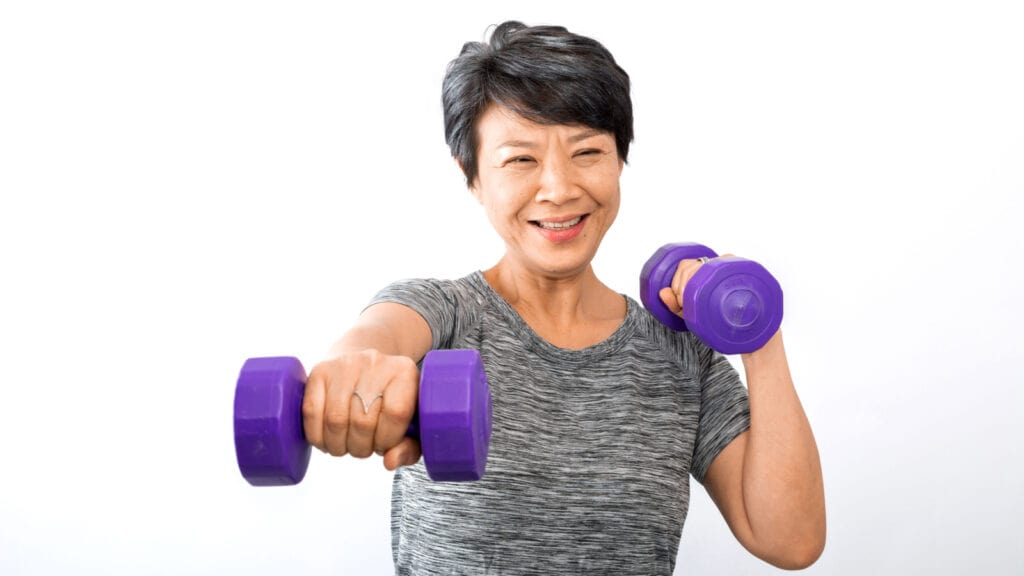Why Women Over 50 Should Lift Weights: Building Strength, Health, and Confidence
As women age, they face unique health challenges that can affect their physical well-being, confidence, and overall quality of life. However, one powerful and often overlooked way to combat these challenges is through weightlifting. Strength training for women over 50 is not just about building muscle; it is a holistic approach to improving health, enhancing longevity, and empowering individuals to lead vibrant lives.
Here are the many reasons why women over 50 should embrace weightlifting and how it can transform their bodies and minds.
1. Combat Age-Related Muscle Loss

As women age, they naturally lose muscle mass in a process known as sarcopenia. Starting in their 30s, women can lose about 3-5% of their muscle mass per decade, and this loss accelerates after 50. Muscle mass is essential for maintaining strength, balance, and mobility. Weightlifting is one of the most effective ways to slow or even reverse muscle loss, helping women stay strong and independent.
By incorporating regular strength training into their routines, women over 50 can rebuild lost muscle and maintain the functional strength needed for daily activities, such as climbing stairs, carrying groceries, or playing with grandchildren.
2. Improve Bone Density and Prevent Osteoporosis

Osteoporosis is a significant concern for women as they age, particularly after menopause when estrogen levels decline. Estrogen plays a critical role in bone health, and its reduction can lead to weakened bones and an increased risk of fractures. According to the National Osteoporosis Foundation, about one in two women over 50 will break a bone due to osteoporosis.
Weightlifting stimulates bone growth by applying stress to the bones, encouraging them to become denser and stronger. Exercises such as squats, lunges, and deadlifts are particularly effective for strengthening the spine, hips, and legs—areas most prone to fractures in women with osteoporosis.
3. Boost Metabolism and Support Healthy Weight

Metabolism tends to slow with age, making it easier to gain weight and harder to lose it. Weightlifting can help counteract this by increasing muscle mass, which in turn boosts resting metabolic rate. Muscle tissue burns more calories than fat, even at rest, meaning that women who lift weights are better equipped to manage their weight.
Moreover, strength training can improve insulin sensitivity and blood sugar regulation, reducing the risk of type 2 diabetes—a condition that becomes more prevalent with age.
4. Enhance Joint Health and Reduce Pain

Contrary to popular belief, weightlifting can be highly beneficial for joint health, even for those with arthritis or other joint issues. Strengthening the muscles around joints provides better support, reduces stress on the joints, and can alleviate pain. For women over 50 dealing with conditions like osteoarthritis, a well-designed strength training program can significantly improve mobility and quality of life.
Low-impact weightlifting exercises, such as leg presses or resistance band workouts, can be tailored to individual needs, ensuring that women can strengthen their bodies without causing undue strain.
5. Improve Balance and Reduce Fall Risk

Falls are a leading cause of injury in older adults, and women are at a higher risk due to factors like reduced muscle mass and bone density. Weightlifting improves not only strength but also balance and coordination, which are crucial for preventing falls. Exercises that focus on core stability, such as planks and weighted carries, can help women maintain better posture and steadiness.
Additionally, strengthening the lower body through exercises like squats and step-ups enhances leg strength and stability, further reducing the likelihood of falls.
6. Enhance Mental Health and Cognitive Function

The benefits of weightlifting extend beyond the physical realm. Regular strength training has been shown to boost mental health by reducing symptoms of anxiety and depression. Exercise releases endorphins, the body’s natural mood elevators, promoting a sense of well-being and reducing stress.
Emerging research also suggests that strength training can improve cognitive function. It may enhance memory, focus, and overall brain health by increasing blood flow to the brain and promoting the release of growth factors that support neural health. For women over 50, these mental benefits are as crucial as the physical ones.
7. Support Heart Health

Cardiovascular disease is the leading cause of death among women, and its risk increases with age. While aerobic exercise is often recommended for heart health, weightlifting also plays an important role. Strength training lowers blood pressure, improves cholesterol levels, and enhances circulation. Combined with other forms of exercise, it provides a comprehensive approach to maintaining a healthy heart.
8. Build Confidence and Empowerment

One of the most rewarding aspects of weightlifting is the confidence it instills. Lifting weights allows women to see tangible progress in their strength and capabilities, fostering a sense of empowerment. Many women over 50 find that weightlifting transforms their self-image, helping them feel more capable and resilient in all areas of life.
The physical changes—toned muscles, improved posture, and a stronger frame—also contribute to a sense of pride and satisfaction. Weightlifting proves that age is no barrier to achieving physical and mental goals.
9. Improve Sleep Quality

Sleep disturbances become more common with age, particularly during and after menopause. Weightlifting has been shown to improve sleep quality by helping regulate sleep patterns, reducing stress, and promoting relaxation. Women who engage in regular strength training often find it easier to fall asleep and stay asleep, leading to better overall health and energy levels.
10. Tailor Workouts to Individual Needs

Weightlifting is highly adaptable, making it suitable for women of all fitness levels and health conditions. Beginners can start with light weights, resistance bands, or bodyweight exercises, gradually progressing as their strength improves. Working with a qualified trainer or joining a fitness class designed for older adults can provide guidance and ensure proper form.
The variety of weightlifting exercises also allows women to focus on specific areas of concern, such as building core strength, improving posture, or rehabilitating from an injury.
Getting Started with Weightlifting

For women over 50 who are new to weightlifting, the key is to start slow and prioritize safety. Here are some tips to get started:
- Consult a Professional: Speak with a doctor or physical therapist to ensure you’re healthy enough for strength training. Consider working with a certified trainer to learn proper techniques.
- Begin with Basics: Start with bodyweight exercises or light resistance, such as dumbbells or resistance bands.
- Focus on Form: Proper form is essential to prevent injuries. Avoid rushing through exercises and prioritize quality over quantity.
- Progress Gradually: As you become stronger, increase the weight, repetitions, or intensity of your workouts.
- Be Consistent: Aim for at least two to three strength-training sessions per week, allowing time for rest and recovery.
- Listen to Your Body: Pay attention to how your body feels and adjust your workouts accordingly. Rest if you feel pain or discomfort.
Conclusion

Weightlifting is a game-changer for women over 50. It combats the physical challenges of aging, enhances mental well-being, and empowers women to live their best lives. Whether your goal is to build strength, prevent osteoporosis, improve balance, or simply feel more confident, strength training offers a path to greater health and vitality.
Age is not a limitation; it is an opportunity to redefine what is possible. By embracing weightlifting, women over 50 can unlock their potential and enjoy a stronger, healthier, and more vibrant future.
Staying Active After 50: Smart Sports Choices for Later in Life

Back in the late 70s, when I was in my late teens, I used to roller skate. Not incidentally. I taught, I performed, I was sometimes on my skates 14 hours a day. I was good at it. Then after not skating for over 40 years, I decided to get back on my skates. I was excited at the idea, a bit anxious, and knew I needed to be safe.
I took it slowly, and even on day two of being back at the roller rink, some muscle memory came back, but there was much less flexibility and stamina. It got me thinking about other seniors who might want to get back to a sport, or to start a new one. Let’s look at how to do it right. (PS: roller skating is not one of the sports suggested for seniors).
READ: Staying Active After 50: Smart Sports Choices for Later in Life
New to Fitness? Here’s How to Start Your Journey Without Feeling Overwhelmed!

Starting on a fitness journey can be intimidating, especially if you’ve never worked out before – or have had a long break away from the gym. The thought of stepping into a gym or even starting an exercise routine at home might seem overwhelming, but it doesn’t have to be. With the right mindset, a solid plan, and a focus on gradual progress, anyone can begin working out and build a healthier, more active lifestyle.
READ: New to Fitness? Here’s How to Start Your Journey Without Feeling Overwhelmed!
3 Simple Somatic Movements You Can Do To Calm Your Nervous System

Daily life can be unnerving. And it’s easy to go from calm to anxious or nervous in a flash. What’s harder is to go from anxious or nervous to calm.These simple movements that I am going to share here have been found to successfully move an individual from a state of anxious nervousness to a state of calm. Read: 3 Simple Somatic Movements You Can Do To Calm Your Nervous System
Join Us

Join us on this empowering journey as we explore, celebrate, and elevate “her story.” The Queen Zone is not just a platform; it’s a community where women from all walks of life can come together, share their experiences, and inspire one another. Welcome to a space where the female experience takes center stage. Sign up for our newsletter so you don’t miss a thing, Queen!







